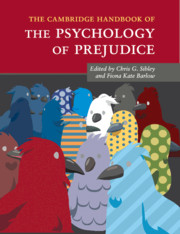Book contents
- Frontmatter
- Dedication
- Contents
- List of Figures
- List of Tables
- Notes on the Contributors
- Part I General Theoretical Perspectives
- Part II Prejudice in Specific Domains
- Part III Prejudice Reduction and Analysis in Applied Contexts
- 20 Recent Developments in Intergroup Contact Research: Affective Processes, Group Status, and Contact Valence
- 21 From Prejudice Reduction to Collective Action: Two Psychological Models of Social Change (and How to Reconcile Them)
- 22 Self-Regulation Strategies for Combatting Prejudice
- 23 Antecedents and Consequences of Evaluative Concerns Experienced During Intergroup Interaction: When and How Does Group Status Matter?
- 24 Stereotypicality Biases and the Criminal Justice System
- 25 Prejudice, Stigma, Bias, Discrimination, and Health
- 26 Development of Delegitimization and Animosity in the Context of Intractable Conflict
- 27 Interventions in Real-World Settings: Using Media to Overcome Prejudice and Promote Intergroup Reconciliation in Central Africa
- 28 Identification with All Humanity: The Antithesis of Prejudice, and More
- 29 It's All About Ignorance: Reflections from the Blue-eyed/Brown-eyed Exercise
- Index
- References
26 - Development of Delegitimization and Animosity in the Context of Intractable Conflict
from Part III - Prejudice Reduction and Analysis in Applied Contexts
Published online by Cambridge University Press: 17 November 2016
- Frontmatter
- Dedication
- Contents
- List of Figures
- List of Tables
- Notes on the Contributors
- Part I General Theoretical Perspectives
- Part II Prejudice in Specific Domains
- Part III Prejudice Reduction and Analysis in Applied Contexts
- 20 Recent Developments in Intergroup Contact Research: Affective Processes, Group Status, and Contact Valence
- 21 From Prejudice Reduction to Collective Action: Two Psychological Models of Social Change (and How to Reconcile Them)
- 22 Self-Regulation Strategies for Combatting Prejudice
- 23 Antecedents and Consequences of Evaluative Concerns Experienced During Intergroup Interaction: When and How Does Group Status Matter?
- 24 Stereotypicality Biases and the Criminal Justice System
- 25 Prejudice, Stigma, Bias, Discrimination, and Health
- 26 Development of Delegitimization and Animosity in the Context of Intractable Conflict
- 27 Interventions in Real-World Settings: Using Media to Overcome Prejudice and Promote Intergroup Reconciliation in Central Africa
- 28 Identification with All Humanity: The Antithesis of Prejudice, and More
- 29 It's All About Ignorance: Reflections from the Blue-eyed/Brown-eyed Exercise
- Index
- References
Summary
Understanding acquisition and development of stereotypes and prejudice by young children in the context of intractable conflicts is a special challenge for social, developmental, and political psychologists, because these concepts play a major role in the dynamics of the hostile intergroup relations between the rivals (i.e., the parties involved in intractable conflicts). In this type of conflict, societies, as a result of the severe conditions of life, develop and later maintain sociopsychological repertoires, of which extremely negative stereotypes and strong prejudice are an inseparable part. The very negative stereotypes are denoted in delegitimization, defined as follows:
Categorization of a group, or groups, into extremely negative social categories that exclude it, or them, from the sphere of human groups that act within the limits of acceptable norms and/or values, since these groups are viewed as violating basic human norms or values and therefore deserve maltreatment.
(Bar-Tal & Hammack, 2012, p. 30)Prejudice refers to the attitude that people hold toward another group (e.g., Leyens, Yzerbyt, & Schadron, 1994; Stroebe & Insko, 1989). However, in the context of intractable conflict, the negative attitude experienced by rival society members is strong. Therefore, we refer to such prejudice as animosity, which conjures emotions of hatred and anger, to stress its particular nature (see Jung et al., 2002). Though delegitimization and animosity are learned similarly as are all stereotypes and attitudes, they are special reflections of the context of intractable conflicts. They are acquired by children as a direct result of their exposure to violence, and other experiences as well, and are imparted to them implicitly and explicitly by agents of socialization. These agents include the family, as well as those at institutionalized levels, through educational systems, media, or political organizations. This chapter elucidates the unique process of the early acquisition of delegitimization (very negative stereotyping) and animosity (very strong prejudice) by children who grow up in societies that are involved in intractable conflict with all its implications. First, the chapter elaborates on the nature of the intractable conflicts, as the unique context in which children develop and acquire their intergroup repertoire of stereotypes and prejudice.
- Type
- Chapter
- Information
- The Cambridge Handbook of the Psychology of Prejudice , pp. 582 - 606Publisher: Cambridge University PressPrint publication year: 2016
References
- 9
- Cited by



